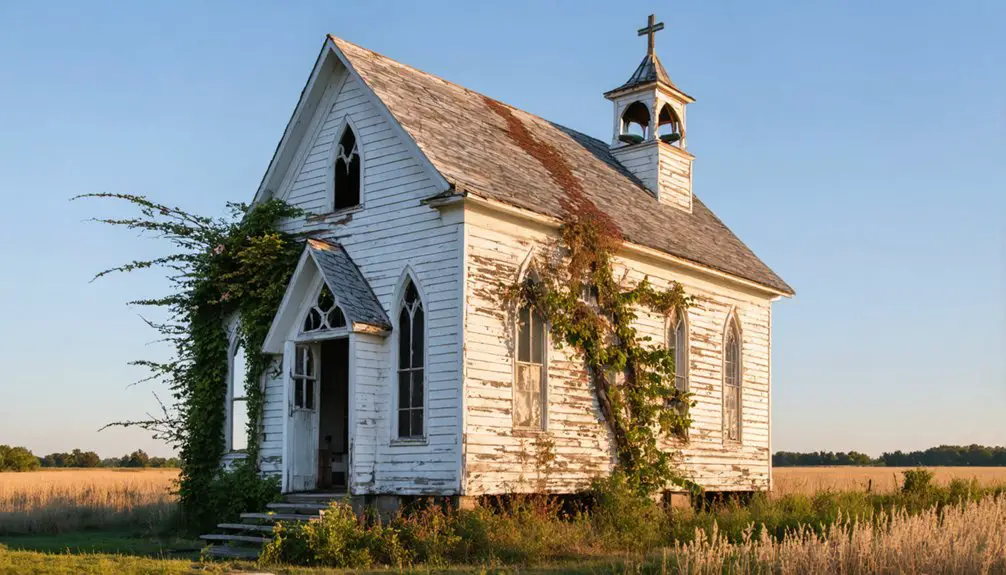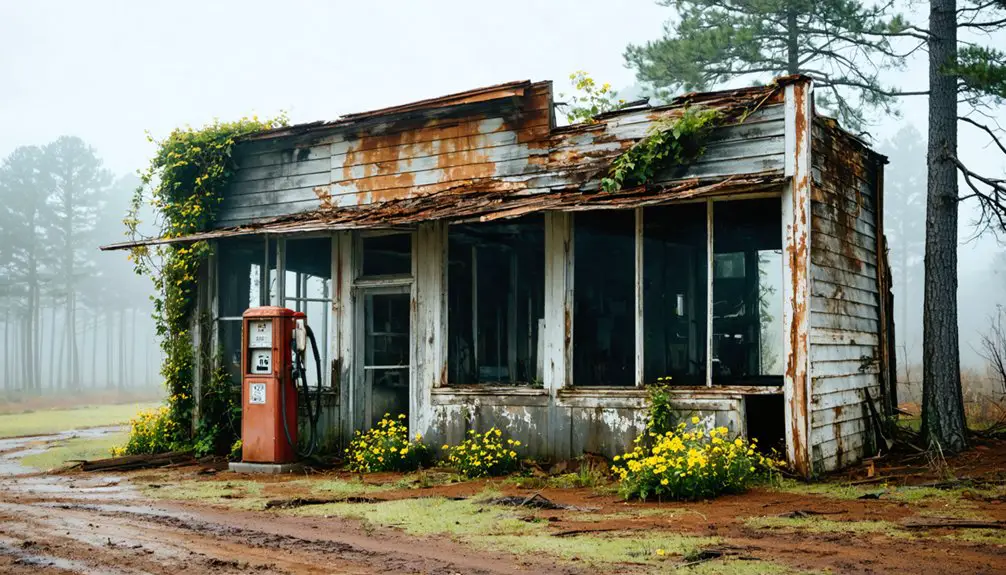You’ll discover Grand Gulf’s dramatic transformation from Mississippi’s third-largest town into a haunting ghost town. Founded in 1828 by three entrepreneurs, it flourished as a bustling river port of 1,000 residents by the 1830s. The Civil War, devastating natural disasters, and the mighty Mississippi River’s westward shift ultimately sealed its fate. Today, pine trees and dense vegetation have reclaimed this once-prosperous trading hub, though its preserved ruins tell compelling stories of its remarkable past.
Key Takeaways
- Grand Gulf transformed from Mississippi’s third-largest town into a ghost town due to Civil War destruction and natural disasters.
- The Mississippi River’s erosion, flooding, and westward shift destroyed the town’s foundations and left it landlocked by 1900.
- Multiple catastrophes, including an 1853 tornado, fires, and wartime damage, contributed to Grand Gulf’s abandonment and decline.
- Today, pine trees and vegetation have overtaken abandoned buildings, with only scattered ruins of the commercial district remaining.
- The site is now preserved as Grand Gulf Military Park, protecting historical structures and educating visitors about its rich past.
The Birth of a Mississippi River Trading Hub
Nestled at the strategic confluence of the Mississippi and Big Black Rivers, Grand Gulf emerged as an essential trading hub in the early 18th century under French settlement.
When the U.S. gained control in 1798, you’d have witnessed the town’s rapid transformation as trading dynamics shifted toward American commerce.
The town’s formal establishment in 1828 by Ezra Marble, Turpin White, and Amos Whiting marked the beginning of its economic evolution.
They mapped out 80 blocks, creating a foundation for what would become Mississippi’s third-largest town.
By the late 1830s, you’d have found a bustling community of nearly 1,000 residents, complete with stores, a tavern, post office, and stage line to Port Gibson.
The town’s position near a massive whirlpool – hence the name “Grand Gulf” – didn’t deter its growth into a formidable river port.
The town’s prosperity attracted numerous merchants, including Jewish peddlers who established successful businesses in the growing community.
Cotton drove the local economy, with the port shipping an impressive 37,770 bales between September 1834 and May 1835.
Life Along the Mighty Mississippi
During its heyday as a Mississippi River port town, Grand Gulf bustled with the constant flow of steamboat commerce and river trade.
You’d have found a vibrant community spanning 80 city blocks, where river commerce shaped the social dynamics of daily life.
- Merchants operated busy storefronts and warehouses, while cotton from surrounding plantations moved steadily through the docks.
- Stagecoaches rumbled between Grand Gulf and Port Gibson, connecting the river trade to inland communities.
- Local taverns served as gathering spots where steamboat captains, merchants, and travelers exchanged news and conducted business.
- Wealthy landowners built impressive homes overlooking the river, while workers’ quarters and businesses filled the lower town.
Much like the town of Rodney, Grand Gulf’s cotton industry created a thriving economic hub that supported multiple stores, banks, and social institutions.
By the late 1830s, the town reached its peak with over 1000 inhabitants residing in this thriving river port.
Unfortunately, the town’s prosperity wouldn’t last, as natural disasters and the looming Civil War would soon alter Grand Gulf’s destiny forever.
Natural Forces vs. Human Settlement
You’ll find Grand Gulf’s fate was sealed by an unrelenting Mississippi River that carved away over 50 blocks of the settlement between 1853-1860, including its essential business district.
Nature released a devastating combination of forces against the town, as the river’s erosion combined with a catastrophic 1853 tornado to systematically destroy infrastructure and undermine the harbor’s functionality.
Despite multiple attempts to rebuild after fires and wartime destruction, the westward shift of the Mississippi River by 1900 left the former port town landlocked, effectively ending its role as a commercial hub.
River’s Unstoppable Power
Throughout history, the mighty Mississippi River has demonstrated its overwhelming force against human settlements, with Grand Gulf serving as a prime example of nature’s dominance over civilization.
The river’s dynamics have repeatedly overwhelmed human attempts to control its raw power, with flooding impacts that reshape entire communities. The Great Flood of 1927 devastated communities across seven states, forcing the evacuation of 500,000 people and causing $1 billion in damages. Modern flood events continue to challenge communities, with water levels near Memphis reaching heights that nearly matched 1937 records.
You’ll find the Mississippi’s unstoppable force revealed through:
- Peak flows exceeding 2.3 million cubic feet per second, overwhelming even modern flood control systems
- Extended flood periods lasting months, making permanent settlement nearly impossible
- Devastating erosion that literally washes away the foundations of riverside communities
- Rapid channel changes that can transform viable ports into abandoned backwaters
Despite humanity’s best engineering efforts, including levees and channel controls, the river continues to assert its dominance, reminding us that nature ultimately sets the rules.
Nature’s Perfect Storm
The systematic decline of Grand Gulf emerged from an extraordinary convergence of natural forces that battered the settlement between 1843 and 1860.
You’d have witnessed yellow fever’s epidemic impact in 1843, decimating the population and discouraging new settlers from arriving. A decade later, in 1853, a devastating tornado destroyed much of the town’s infrastructure, weakening its resilience against future challenges.
Nature’s assault continued as the Mississippi River began shifting westward, eroding over 50 city blocks by 1860.
The settlement decline accelerated when floods repeatedly threatened remaining structures, while the river’s changing course cut off essential trade access.
This relentless combination of disease, severe weather, and river dynamics, compounded by human conflicts, transformed a once-thriving river port into a ghost town.
Man-Made Defense Crumbles
Despite impressive Confederate engineering efforts to fortify Grand Gulf during the Civil War, both natural forces and military conflict gradually dismantled the town’s defensive capabilities.
The strategic fortifications decay occurred through a relentless combination of environmental and human factors.
- The Mississippi River’s westward shift eroded 50-52 blocks by 1860, undermining military engineering projects and defensive structures.
- Confederate forts on both riverbanks initially succeeded in repelling Union forces but couldn’t withstand nature’s persistent assault.
- Multiple disasters, including an 1853 tornado and steamboat explosion, weakened Grand Gulf’s defensive infrastructure.
- Union forces eventually burned much of the town, while post-war flooding and erosion prevented any meaningful reconstruction of military positions.
Like the nearby town of Rodney which peaked at 4,000 residents by 1860, Grand Gulf faced significant population decline due to natural disasters and changing river conditions.
The ultimate failure of Grand Gulf’s defenses demonstrates how even the most determined human efforts can’t always overcome nature’s power.
Strategic Significance During the Civil War

Situated at the critical junction of the Mississippi and Big Black Rivers, Grand Gulf emerged as an essential Confederate stronghold during the Civil War, serving as a formidable barrier against Union advances toward Vicksburg.
Two key fortifications, Fort Cobun and Fort Wade, dominated the military strategy, with their artillery batteries effectively disrupting Union river navigation and supply lines. The battle on April 29, 1863 resulted in 75 Union casualties. Admiral Porter’s naval operations played a crucial role in transporting Union troops across the Mississippi River during this period.
The Confederate fortifications of Fort Cobun and Fort Wade wielded devastating artillery power, effectively choking Union supply routes along vital waterways.
You’ll find that Grand Gulf’s significance went beyond its defensive capabilities. The post maintained crucial Confederate communication routes between the eastern and western territories.
When Union forces under Grant attempted to capture the position, Confederate guns proved so effective that Federal ships sustained heavy damage and withdrew. This resistance forced Grant to alter his plans, ultimately choosing Bruinsburg as his crossing point in the campaign to capture Vicksburg.
The Town That Nature Reclaimed
Over time, nature’s relentless forces have gradually reclaimed Grand Gulf‘s original footprint, transforming this once-bustling river town into a haunting tribute to environmental dominance. The Mississippi River‘s persistent flooding has shaped the town’s destiny, leaving behind ghostly remnants of its former glory.
Today, you’ll find nature’s reclamation evident throughout the landscape:
- Pine trees and dense vegetation have overtaken abandoned roadways and building foundations.
- The historic Mt. Zion Baptist Church stands partially submerged, its structure weakened by recurring floods.
- Only scattered ruins remain of the original commercial district and residences.
- Modern residents adapt to nature’s rhythm, living in elevated mobile homes and displaying flood survivor signs.
While some hardy souls still call Grand Gulf home, the wilderness has largely triumphed over human settlement, creating a stark representation of nature’s power. Visitors can witness this transformation from the park’s 75-foot observation tower, offering a panoramic view of nature’s reclamation of the historic town.
From Bustling Port to Abandoned Settlement
While French settlers first established Grand Gulf in the early 18th century, the town’s transformation into a major Mississippi River port didn’t occur until American settlers arrived in the late 1790s.
By 1835, you’d have found Grand Gulf thriving as Mississippi’s third-largest town, shipping 38,000 cotton bales annually with over 20 steamboats stopping weekly.
The town’s economic decline began dramatically during the Civil War. In 1863, Confederate fortifications made Grand Gulf a target for Union forces, leading to devastating artillery battles.
By July 22, Union officers reported the town in ruins. This destruction, coupled with the population shift away from the damaged infrastructure, sealed Grand Gulf’s fate.
The once-bustling port that had surpassed Port Gibson and attracted diverse merchants, including Jewish traders like the Levy brothers, couldn’t recover its former prosperity.
Preserving Grand Gulf’s Historical Legacy
Today you’ll find Grand Gulf’s historical legacy carefully protected through systematic archaeological preservation, which safeguards both battlefield remnants and Native American artifacts across its 400 acres.
The site’s museum actively expands its collections of Civil War relics and early settlement items, providing visitors with tangible connections to the area’s rich past.
Dedicated restoration work continues on structures like the preserved Sacred Heart Catholic Church and other relocated historical buildings, ensuring these architectural treasures remain intact for future generations to experience.
Archaeological Site Protection
Since its establishment as a protected historic site, Grand Gulf‘s archaeological preservation has operated under a complex framework of state and federal regulations. The Mississippi Department of Archives and History and Nuclear Regulatory Commission oversee the site’s archaeological integrity, while coordinating with the State Historic Preservation Office to maintain strict preservation standards.
Key preservation challenges you’ll find at Grand Gulf include:
- Natural environmental changes affecting the original battlefield landscape
- Urban development threatening unprotected archaeological zones
- River course shifts and levee construction altering historic context
- Unauthorized ground disturbance risking artifact loss
Despite these challenges, extensive archaeological work has documented Confederate fortifications, artillery positions, and prehistoric artifacts.
You’ll find protective measures in place, including fenced areas around sensitive mound regions and administrative controls governing ground-disturbing activities within the site’s boundaries.
Museum Collection Expansion
The Grand Gulf Museum‘s collection has grown substantially from its 1967 founding into an extensive repository spanning prehistoric finds to mid-20th century artifacts.
You’ll discover half the collection focuses on Civil War history, featuring detailed battle maps, military equipment, and personal items that bring the conflict to life.
The museum’s artifact preservation efforts encompass everything from a rare George Washington letter to a preserved Civil War ambulance.
Through strategic acquisitions, you’ll find relocated historical structures like the Sacred Heart Catholic Church, complete with original relics.
The museum’s educational outreach integrates these artifacts through thorough labeling, photographs, and scale models that trace Grand Gulf’s development.
Whether you’re interested in prehistoric specimens like Mastodon bones or 1950s memorabilia, you’ll encounter meticulously documented pieces that tell the region’s complete story.
Historic Building Restoration
Through dedicated preservation efforts since 1962, Grand Gulf Military Park has become a sanctuary for endangered historical structures from the surrounding region.
You’ll find carefully restored buildings that showcase restoration techniques focused on architectural authenticity, from the Spanish House’s 1958 renovation to Sacred Heart Catholic Church’s 1983 relocation.
- Original wooden pegs and locally sourced materials like cypress, poplar, and heart pine maintain period-accurate construction methods
- Carpenter Gothic elements of Sacred Heart Catholic Church preserve its distinctive 1868 architectural style
- The Spanish House’s 1790s timbers were meticulously replaced to protect its antebellum character
- Relocated structures, including a dog-trot cabin and grist mill, now stand protected from river damage and decay
These preserved buildings serve as tangible links to Mississippi’s vanished river towns and Civil War heritage.
Frequently Asked Questions
What Happened to the Jewish Merchants and Their Families After Grand Gulf Declined?
In a region where Jews dominated commerce in over 100 towns, you’ll find these merchants and their families preserved their Jewish heritage while establishing a merchant legacy in Port Gibson and throughout Mississippi.
Were There Any Successful Attempts to Rebuild Grand Gulf Elsewhere Nearby?
You won’t find any successful rebuilding efforts near the original site. Most residents relocated to established nearby settlements like Port Gibson, where they could maintain better river access and trading opportunities.
How Deep Was the Whirlpool That Gave Grand Gulf Its Name?
You won’t find recorded measurements of the whirlpool’s depth in historical records. The name came from French explorers who saw the swirling eddy formed by river currents hitting rock formations.
What Indigenous Peoples Inhabited the Grand Gulf Area Before French Settlement?
Hold onto your hat – you’d find the Natchez people leading the way, establishing their cultural heritage through mound-building societies, while Choctaw and various petites nations like Mobilians called this area home.
Did Any of Grand Gulf’s Original Businesses Relocate to Other Mississippi Towns?
You won’t find clear evidence of business migration from the original establishments, though nearby Port Gibson likely absorbed much of the region’s economic activity and historical significance after the town’s decline.
References
- https://marieqrogers.com/2015/08/31/the-ghost-town-that-wont-die/
- https://www.legendsofamerica.com/ms-grandgulf/
- https://theforgottensouth.com/rodney-mississippi-ghost-town-history-tour/
- https://en.wikipedia.org/wiki/Grand_Gulf
- https://www.isjl.org/mississippi-grand-gulf-encyclopedia.html
- https://www.isjl.org/mississippi-port-gibson-encyclopedia.html
- https://www.mdah.ms.gov/sites/default/files/2020-04/AR-13.pdf
- https://www.hmdb.org/m.asp?m=105720
- https://kids.kiddle.co/Grand_Gulf
- https://www.weather.gov/safety/flood-states-ms



